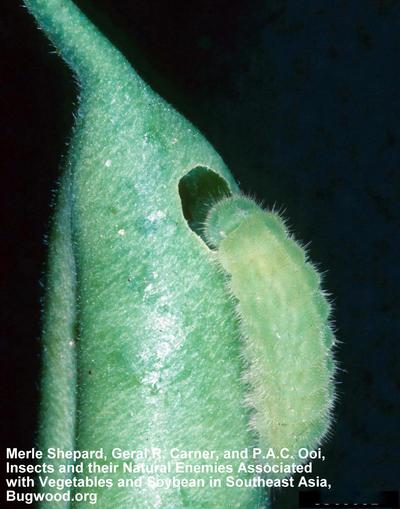Gram Blue Butterfly
Euchrysops cnejus
Insect
In a Nutshell
- Boreholes on buds, flowers and young pods.
- Slug like caterpillar with a red line, short black hairs on the body.
- Bluish butterfly (male) with distinct black spots.
Can also be found in
Symptoms
Symptoms are apparent on buds, flowers and seed pods, where entry or feeding holes can be found. Pod damage is usually characterized by multiple holes per pod. The holes secrete sap and the edge of the holes turns black.
Recommendations

Organic Control
Use natural enemies to attack all lepidopteran pests in order to control the grass blue butterfly population. Release egg parasitoid Trichogramma sp. at weekly intervals @ 0.6 lakh/acre/week for four times. Conserve Telonomus spp. (an egg parasitoid) and Apnateles spp. (a larval parasitoid) by not spraying any pesticides when parasitoids are being observed. Larvae can also be controlled by insecticides targeting other caterpillars. Cover your plants thoroughly with Bacillus thuringiensis (at least 100 l water/ha). Neem oil can also keep the pest under control.

Chemical Control
Always consider an integrated approach with preventive measures together with biological treatments, if available. No pesticides are registered specifically against grass blue butterfly. Most products targeting other species of Lepidoptera will also control this pest. Profenofos was suggested to control the E. cnejus effectively.
What caused it?
The symptoms are caused primarily by the larva of Euchrysops cnejus. The adult male is light purple whilst the female is rather heavily black-dusted with its wing bases pale shining blue. Females can lay from 60 to 200 eggs in its lifetime and place them singly on shoots, flower buds or leaves. The larva is typically stout, flat pale green or yellow, measuring about 13 mm with a red line and short black hairs on its bodies. They are often attended by black ants. Due to their colouring and their feeding spots, the caterpillars are hard to find despite being diurnal (active during the daytime). The larvae feed on flowers and young pods, especially in pulse crops and bore into them. Pupation occurs on the leaves.
Preventive Measures
- Plant your crop with enough spacing and avoid early or late sowing.
- Rake the soil regularly during the period of infestation to kill larvae and pupae.
- Monitor your field for signs of the pest.
- Collect and destroy the larvae, pupae and adults.



